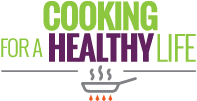Bad fats, good fats, trans fats, cholesterol, triglycerides, saturated, unsaturated − what’s the difference anyway? The news makes fats in our diet seem so confusing. In this post, take a dive into the topic of fats and learn about which ones are part of a balanced diet and the ones that you should pass up.
The federal dietary guidelines state that a healthy eating pattern limits intake of saturated fat and trans fat, in addition to limiting added sugars and sodium. The guidelines specifically recommend less than ten percent of calories per day should come from saturated fats.
There are different types of lipids, which are more commonly referred to as “fat.” Understanding the role each of these types of fat play in the human body and in human health is the first step toward regulating how much and what kinds of fat to include in a healthy dietary pattern.
UNDERSTANDING FATS: TRANS AND SATURATED
Trans fat was banned by the U.S. Food and Drug Administration (FDA) in June 2015. Food companies have three years to remove artificial transfat from their food supplies. Although trans fat does occur naturally in very small amounts in some meat and dairy products, synthesized transfat cannot be metabolized by  the body because of a chemical change that occurs during food processing.
the body because of a chemical change that occurs during food processing.
Rishipal Bansode, PhD, with the NCA&T Center for Excellence in Post-Harvest Technologies, an NCRC partner, says that trans fat has “no benefits to humans, and they are directly related to cardiovascular disease.”
Although trans fat is on its way to being removed from the food supply, look for “partially hydrogenated oils” (PHOs) on food ingredient labels to avoid consuming it. Even if a Nutrition Facts Label lists trans fat as 0 grams per serving, due to FDA rounding rules the product may still contain a small amount of trans fat per serving.
Saturated fat, a type of fatty acid, comes from animal products like meat and dairy as well as tropical oils, such as palm and coconut. Bansode says that a diet especially high in saturated fats leads to an enhanced risk for developing heart disease, metabolic syndrome, diabetes, and stroke.
UNDERSTANDING FATS: SATURATED AND CHOLESTEROL
Cholesterol is a fatty substance found in cell walls. It is made and used by the body to produce hormones and vitamin D as well as bile acids that aid in the digestion of fats. Cholesterol exists in two forms, dietary cholesterol from foods and blood cholesterol. Blood cholesterol is made up of lipoproteins that carry cholesterol throughout the body. Low density lipoprotein (LDL) is considered the “bad” form, and high density lipoprotein (HDL) is considered the “good” form.
Here’s why.
LDL carries cholesterol from the liver to cells where it is stored. High levels can lead to buildup in the arteries that can increase the risk for heart disease. LDL levels increase with a diet high in saturated and trans fat. On the other hand, HDL removes cholesterol from the cells and delivers it to the liver to be broken down or excreted as waste. Higher levels of HDL are good and can lower the risk for heart disease. Eating more unsaturated fat can help to increase levels of HDL in the body.
“Contrary to popular belief, cholesterol is okay to eat,” says Registered Dietitian Steph Saullo, with NCRC partner the UNC Chapel Hill Nutrition Research Institute (NRI). “Our dietary cholesterol intake does not affect blood cholesterol. Other things like saturated fats and trans fats affect blood cholesterol.”
UNDERSTANDING FATS: CHOLESTEROL AND TRIGLYCERIDES
Think of triglycerides as the form fat takes when it is stored in the body. Any calories eaten that are not used by the body, whether they are from fat, protein, or carbohydrates, are converted into triglycerides, which are then stored in fat cells. The body can draw upon this energy when needed, but when triglyceride levels get too high they may accumulate in the blood and contribute to heart disease.
UNDERSTANDING FATS: MONOUNSATURATED AND POLYUNSATURATED
Monounsaturated and polyunsaturated fats come from avocado, nuts, fish, seeds and oils, such as canola, olive, vegetable, and peanut. Cold-water fish like salmon have higher amounts of omega-3 fatty acids, specifically DHA and EPA that are essential fatty acids. Unsaturated fats are beneficial to the body in a couple of different ways.
“Vitamins A, D, K and E are fat-soluble and that means we need fat to absorb them,” Saullo explains. “So by eating these fat-soluble vitamins with a source of fat, our body is more efficient at absorbing these nutrients.”
Understanding and recognizing the difference between saturated and unsaturated fats is important to human health. “What we really want to do in a heart healthy diet is replace saturated and trans fat with good, unsaturated fat,” Saullo says. “If we are replacing saturated fats with unsaturated fats, we see health benefits.”
Trying new recipes that include sources of unsaturated fat like avocados is one way to increase the intake of healthy fats. Avocados are the only fresh fruit with unsaturated fat, which is mostly monounsaturated, plus nearly 20 vitamins and minerals, including fat-soluble nutrients. Click here for an Avocado Chocolate Mousse recipe.
Other ways to consume more “good fats” include replacing butter or shortening with olive or canola oil and eating nuts and seeds. Read ingredient labels to find products made with unsaturated fats and practice balanced meal planning.
To learn more about the federal dietary guidelines and how to apply them to improve your health, read our series of articles:
Eating Whole Grains
4 Reasons To Eat Vegetables
Added Vs. Natural Sugar
The original article was published on the North Carolina Research Campus website







Leave A Comment